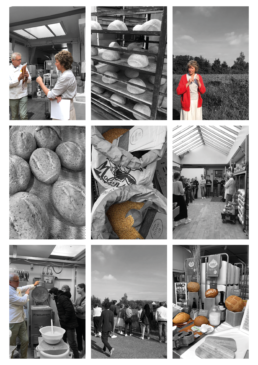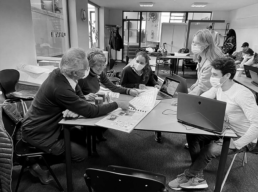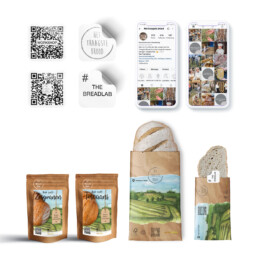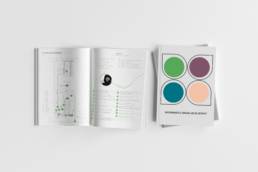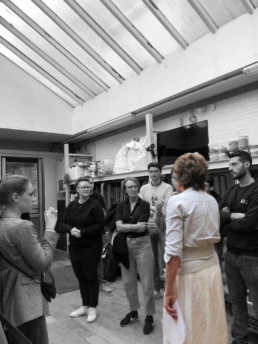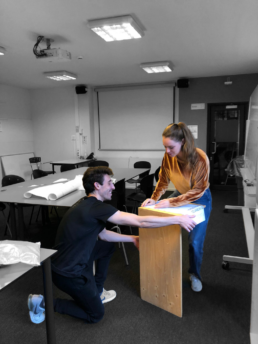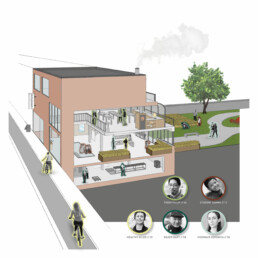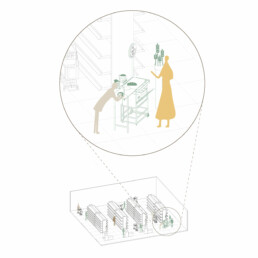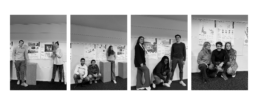Climate change and the increasing world population obliges us to look for a more sustainable and diverse food production system. Bread is one of the oldest prepared foods and the staple food of the Middle east, Central Asia, North Africa Europe, the Americas, Australia and Southern Africa. The search for and implementation of old cereal varieties does not only benefit, but also increases biodiversity and ensures greater resistance to pests and diseases, and a better adaptation to climate change. Moreover, many consumers are more aware than ever before of what is on their plates and are actively looking for food with nutritional added value that is produced locally.
The introduction and processing of old species and varieties in Flanders would therefore be a step in the right direction in order to meet these challenges and trends.
The SSD students investigate the possible future services for the Bread Lab and the necessary supportive service environment(s), the SSD students propose new tangible and intangible concepts for the future Bread Lab in order to support the client in the further development of the site (e.g. building design process) and the service system. Solutions should be viable, inclusive, holistic and circular.
Marc Van Eeckhout and Lutgart Lyen of ‘Het traagste brood’ are passionate about old grains. They want to use them to bake the tastiest bread in the long run.
To make the bread accessible for their everyday customers and to investigate as much time as possible in the baking process of it, they sell their bread mainly through vending machines and supermarkets all over the region of Mechelen. Marc and Lutgart wish to set up their own milling plant in the future in order to shorten the food chain and processing time, to improve the slow preparation process and thereby improving digestibility. Their wish is to provide real bread with authentic flavours and nutritional value to their consumers.
The dream of the client, is to develop a Bread Lab as a location for inviting slow food bread services and experiences. A Bread Lab where research of the potential of old grains and experimenting with recipes could take place, at the same time, be a platform for gaining and sharing old and new knowledge and skills between experts and experts and interest groups (cooking classes, schools, slow food lovers, farmers,…). The projects aims at getting the farmer, miller and baker on the same page.
This Bread Lab is a big investment and is dependent of their building in Hofstade. What kind of new services can be created while their Bread Lab is being build? A ready-made objects that contains the same services as the bread lab, such as learning, meeting, informing, exhibiting, storytelling and sharing can be a solution nowadays. A movable, handy object (e.g. furniture, cart, mini expo booth, trolley) will enable tasting, storytelling and information sessions at several location e.g. supermarkets, slow food events, fairs.
Each student group focused on different aspects, this caused a variation in the design outcomes. The design challenge of Elena and Jeroen was as follows: ‘How easy is it for customers to navigate within all the different services?’ By using this question as their guideline it became more clear that communication to the client is one of the important things to focus on. A happy client is a returning client. When someone feels bonded with the company they will return and bring other people with them. To achieve this ‘Het Traagste Brood’ is not only going to be a bread seller but also going to focus on reaching the people at home. This can be done by going on social media to spread awareness, telling the story of the whole baling process or by workshops in the ‘Breadlab’.
The second group of Julie, Sergi and Nicolas developed a service system on how to act to diverse users while sharing the owner’s expertise & telling the story of the slowest bread in an interactive way. They designed a script for the multiple user journeys based on a handy 2D plan, that reflects the vision and expectations of Marc and Lutgart. Their research question was: ‘How do we build the dream of a multipurpose bread-lab for Broodnodig, while serving the needs of different user groups?’
The group of Oriana, Brent and Tafara have designed a tour through the Bread Lab that looks to: engage the 5 senses, tell a consistent and comprehendible story for different types of users to interact with it. Marc & Lutgaart would like the story of ‘Slow Bread’, from Grain – Flour – Bread to shine. Though it being a strong and informative story, their team identified that it could improve on its’ Engagement, Comprehension and Dependency to benefit both the owners and the visitors. Their design challenge was: ‘How do we design an engaging story and tour for every type of visitor?’
Britt, Paulina and Anthony went into more detail about: ‘How can we raise awareness and teach about the vision of ‘Het traagste brood’ through STORYTELLING?’ They designed MMM – Mini Mobile Model, a portable, foldable box used to present the story of ‘Het traagste brood’ to different audiences. MMM is taken by its owners, Lutgart and Marc, to prospecting and tasting sessions in supermarkets to convince customers of the company’s qualities. The box contains all the necessary tools to tell the story interactively by stimulating all five senses. The Mini Mobile Model is light and easy to transport. It is flexible and can be fully adapted to a specific story according to the occasion and audience because of its modular system. MMM is a “magical box” that makes the story of ‘Het traagste brood’ an artistic and unforgettable experience for the audience.
The design skills of SSD students were developed during this design assignment and their self-confidence as designers was strengthened. They experienced what it is like to work for clients and to convince them of the qualities of Space & Service Design. They have gained new insights in terms of design methodology, thorough pre-research, dealing with clients, working in groups, time tension, user-centred design,… and above all a personal approach used in this project.

